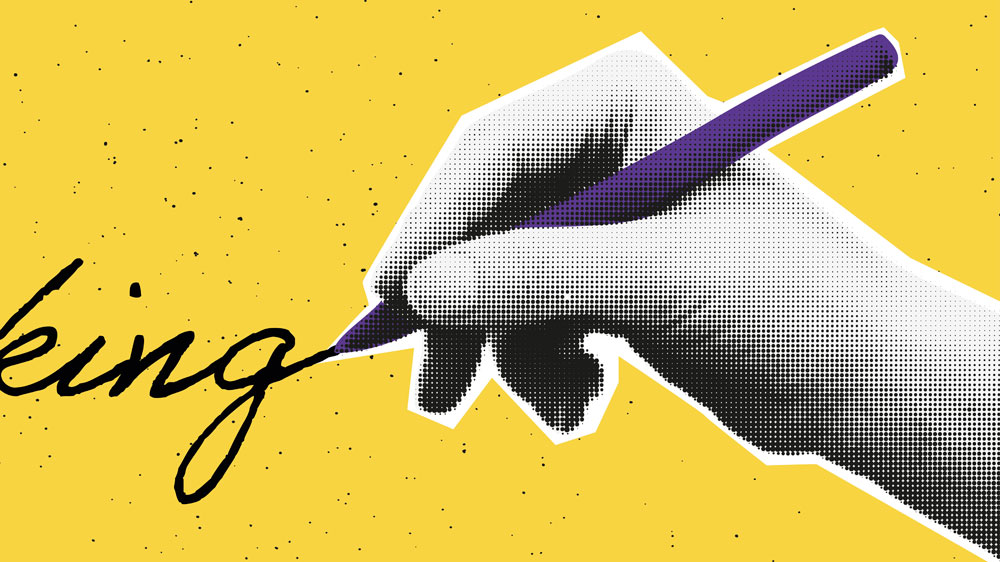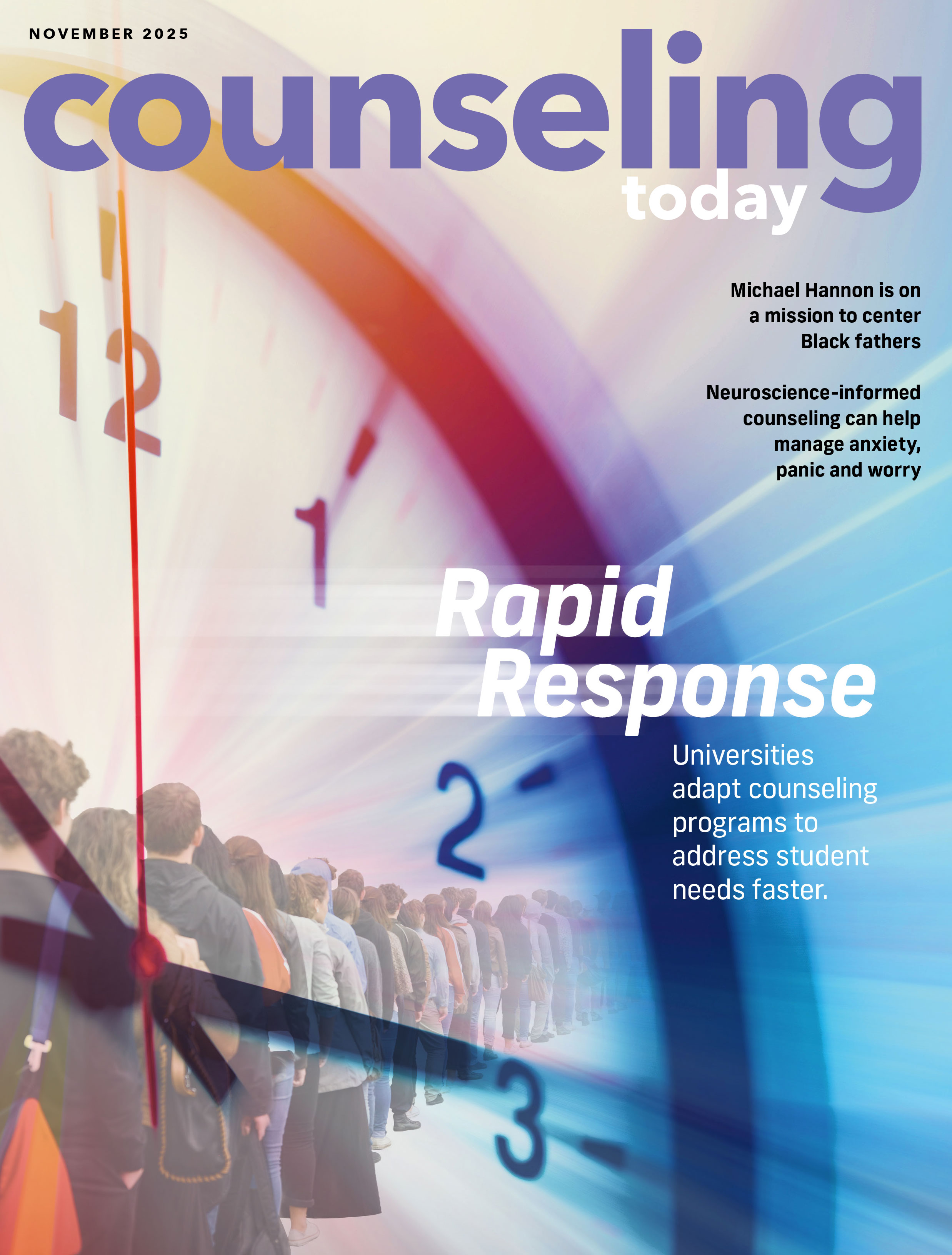Transform Your Note-Taking
By Glenn Cook
May 2025

Early in her career, working for a community mental health agency, Lisa Henderson, LPC-MHSP, would meet with clients and go back to the office to type her handwritten notes into an electronic health record.
The purpose of the notes, she says, was to inform others in her Nashville, Tennessee, office about progress with the clients and to ensure the agency was complying with state regulations. The work was often tedious. “A lot of times it was purely and simply to validate that people were showing up for sessions,” Henderson says.
But there was one unexpected benefit: “I realized this was helping me process, take a step back and see a bigger clinical picture than when I was in the session with the client,” says Henderson, who also has worked in a treatment center and in private practice during her two-plus decades as a licensed professional counselor.
For counselors, note-taking is essential in providing high-quality services and care while meeting the profession’s legal and ethical requirements. Notes serve as your record of interactions and progress with clients as well as support for the decisions you reach about treatment. They also can be a burdensome, onerous and difficult task to keep up with unless you are organized and diligent.
“You have to look at note-taking from a legal, ethical and positive practice perspective,” says John Duggan, EdD, LPC, LCPC, associate professor of counseling and associate ethics fellow at Marymount University in Arlington, Virginia. “Act and write as though you’re documenting something that your client will need to access care in the future and that may appear at some point in front of your peers, the ethics committee or ... the court.”
Productivity consultants often help their clients find efficiencies around labor-intensive or time-consuming tasks such as note-taking. Consultant Sarah Ohanesian says you have to be “clear about purpose and intentionality” in taking notes. “I’m always looking at this from the efficiency perspective,” says Ohanesian, who owns a productivity training and consulting company that helps corporate teams be more productive. She’s based in the Philadelphia area.
“The most important work is helping your [clients]. Are you focused more on taking notes, or are you able to really be present and provide the guidance you’re qualified to provide? If the answer is taking notes, then how can you be the most efficient and effective in providing quality care?” she asks.
How to Approach Note-Taking
Three commonly used note-taking methods are known best by their acronyms: SOAP (Subjective, Objective, Assessment, Plan), DAP (Data, Assessment, Plan) and BIRP (Behavior, Intervention, Response, Plan). All three use standard, structured formats that are designed to capture all vital information.
With SOAP, the counselor’s notes focus first on what the client says, followed by observations about their visit. Both are used in assessing where the client stands at the end of the session, followed by a plan of action for future visits. With DAP, more emphasis is placed on the analysis and treatment plan. The BIRP method documents interventions the counselor uses during a session.
“Figure out the primary focus and goal of the notes and choose a style that aligns with that goal,” says Deb Lee, a certified professional organizer and digital productivity consultant in Washington, D.C. “Choose a method based on what you need from your notes and how easy it would be to keep up with.”
After a session, Duggan says counselors’ notes should be able to answer a series of questions about what took place. “There are certain things we need to pay attention to in our scope of practice,” he explains. “What happened? What type of interventions took place? Was the session with an individual? Was it group? What type of session was held? Who was present? The progress note should promote the clients’ dignity and welfare by tracking therapeutic gains.”
Notes should be objective reports. They “aren’t designed to capture emotion and feeling,” Henderson says. “They’re written with a clinical sterility. I can say the client appeared distressed as evidenced by tears or raised voice or heavy breathing, but I can’t say that the client felt sad. I would have to observe it and document how I came to that conclusion.”
Assume nothing, Duggan says. “You have to be able to back up what you observe, and opinion — even if it’s an informed opinion based on experience — is still an opinion. Provide a narrative and be wary of check boxes and forms that can be open to misinterpretation.”
Lee recommends counselors use templates with clear headlines that are easy to skim or read. “Using a template will help with efficiently creating notes because you’re not always starting from scratch,” she says. “Using an AI tool to efficiently categorize a wide-ranging conversation can help save time as well.”
How to Choose a Method
What method should you use to actually take the notes? Handwritten, typing them into a computer or voice dictation that is later transcribed have long been the standards. Tablets, which also allow for the capture of video, also are used as a note-taking tool.
Voice dictation programs and tablets are fast and hands-free and allow you to capture ideas in the moment, but they can be distracting to clients. Voice dictation also is seen as less effective if you are a visual learner, while tablets are more expensive and have a learning curve.
The newest and most controversial tool is ambient listening software that uses artificial intelligence (AI) to supplement notes. Rapidly becoming common in use, the software also presents legal and ethical considerations that practitioners must consider carefully.
Although Henderson has embraced the use of AI, she says taking notes by hand remains “a useful clinical tool for the counselor to be able to reflect back on what was said.”
“I worry that if we take that out entirely that a counselor might just go from session to session to session and not have the space for themselves to process what took place,” Henderson says. “That could lead to negative outcomes in terms of not taking a step back and seeing the bigger picture for a particular client.”
Like Henderson, both Ohanesian and Lee still take notes by hand because they believe the process helps a person retain more information. “While AI captures everything that’s said, I write down the key parts of the session that I may need to refer back to later,” Lee says. “It’s a mix of tech and pen and paper that works well for me.”
Alexis Haselberger, a San Francisco-based productivity and time management coach, agrees. She says many AI tools now on the market “don’t do a great job, miss things and don’t capture action items appropriately.”
“You may get a summary, but it won’t be nuanced, and you may miss key takeaways,” Haselberger says. “Documenting as you go helps you to avoid relying on your memory so that you can use all that brain power to focus on the task at hand.”
Ohanesian says AI note-taking helps her be more present during meetings. One downside she has noticed, however, is some clients do not like meetings to be recorded.
“People open up more when I’m not recording a meeting. They’re more willing to be vulnerable, share what’s really going on, share their real opinions,” she says. “As soon as we say we’re going to record a meeting, I have found that there’s a different level of resistance that comes in because they’re a little more guarded and a little more reserved.”
Legal and Ethical Requirements
The biggest questions around the use of AI in note-taking are in the legal and ethical space. According to the ACA Code of Ethics, counselors must get informed consent from clients to use an electronic health records package, distance counseling or AI technology. Regulations from the Health Insurance Portability and Accountability Act (HIPAA) around privacy and the sharing of records also must be considered.
“AI and any technology tools that we use have to be in compliance with our ethical and legal codes,” Henderson says. “It’s fairly straightforward that our ethical code does say that we should take notes, that we should keep them for a certain period of time after we’ve discontinued care, and that they should be used in sharing information if other providers need it or the client requests it.”
Duggan and Henderson share concerns that some AI providers want to record and keep notes stored on a remote server. Before using a particular AI tool, counselors need to know whether the tool is embedded in the electronic health record, the ethical codes the AI provider adheres to, whether it is HIPAA compliant, the data storage practices and the security in place to protect against cyber breaches.
“The risk I see with AI is that we have no idea how the client information is being used, where it’s being stored or if it’s being stored by a company that may sell the data or use it for marketing purposes,” Duggan says. “I have no idea if the information will be on a data server in the Grand Cayman Islands, in Switzerland or locally. If a court or licensure board demands notes, how will the professional counselor be able to comply and produce the documentation? How can we be certain the data [are] permanently deleted according to destruction of records policies or state law?”
Henderson sees the value that AI and technology can bring to the counseling profession. She started a company — Synchronous Health, which ThriveWorks acquired last year — that delivered telehealth services with digital support between sessions. But storing AI-recorded notes, she says, could have a detrimental effect.
“What I think is so valuable about counseling is our clients have the ability to say things out loud that they might not otherwise say. They can hear it reflected back to them by someone they trust, and they know that what gets documented is for the benefit of their care,” she says.
“If something gets recorded that the counselor wouldn’t document, something that you processed and worked through in a session but decided wasn’t relevant, things could get really turned upside down with care and how we deliver care,” she says. “That’s a nuance that needs to be protected because I really think it’s the essence of effective counseling.”
Duggan, who was in private practice before moving into academia, says he stresses the importance of self-discipline in note-taking to his students. It was a lesson he learned from his graduate school professor, Linda Seligman, PhD, two decades ago, one that he believes completely transformed his work.
“I wasn’t very good at it in the beginning; I had to force myself to do it,” he says. “But I learned that there’s a reason for this rigor. Note-taking is advocacy, a calling to care for our client. It’s the heart and soul of our ethical responsibility.”


